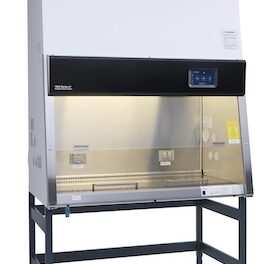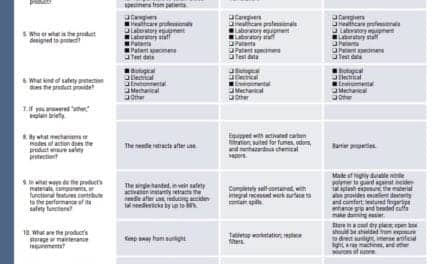This post is a sidebar to our April 2014 feature on Safety Products.
Daniel J. Scungio has previously appeared in CLP’s pages as a source for articles about laboratory safety. It’s a natural association for him, since he and his business are widely known as “Dan the Lab Safety Man.” In connection with the feature article on laboratory safety in CLP’s April 2014 issue, contributing writer Gary Tufel reached out to Scungio for an update on key issues in the world of lab safety.
CLP: What are the latest developments and challenges in lab safety?
Daniel J. Scungio: The latest challenges I hear from my clients include chemical management, improving safety culture, and improving the use of personal protective equipment (PPE) in the lab. Chemical management includes following the precepts of the United Nations’ Globally Harmonized System of Classification and Labeling of Chemicals (GHS), including changes for labeling, pictograms, and safety data sheets (SDSs), in line with the OSHA training required last year. Improving safety culture means having staff wear proper PPE, and following safety regulations.
CLP: What new threats to lab safety have emerged in recent years?
Scungio: Given the recent rise in US disasters affecting hospitals, disaster and emergency management (EM) has become an area of focus in many labs.
CLP: What do labs do differently now as a result of those challenges?
Scungio: Some aren’t doing anything different; others are drafting robust EM plans to suit many types of emergencies. The Centers for Medicare and Medicaid Services (CMS) is in the midst of proposing new hospital requirements that dictate a better response to disasters. There are four elements in the CMS-proposed requirements for hospital EM plans:
- Risk Assessment and Planning. Prior to establishing an emergency plan, a risk assessment must be conducted to determine the organization’s capacities and capabilities that are critical in preparing for a full spectrum of emergencies or disasters. Other names for this process are the hazard vulnerability analysis and the emergency operations plan.
- Policies and Procedures. Facilities are required to develop and implement policies and procedures based on the emergency plan and risk assessment.
- Communication Plan. Facilities are required to develop and maintain an emergency preparedness communication plan that complies with both federal and state laws.
- Training and Testing. Facilities must develop and maintain an emergency preparedness training and testing program.
CLP: How are the safety tools now available to labs better than earlier products?
Scungio: Some are better: electronic access to SDSs and regulations, for example. Others have not changed.
CLP: Where can researchers find statistics on the number of lab injuries or fatalities in the US annually?
Scungio: The Bureau of Labor Statistics puts out lab injury data annually. The numbers have declined in the past few years, which is great. That data can be found at www.bls.gov/iif/oshsum.htm.
CLP: What are the best sources for safety information and guidelines for clinical labs?
Scungio: A number of organizations offer excellent resources about laboratory safety, including the following:
- Centers for Disease Control and Prevention (CDC), Biosafety in Microbiological and Biomedical Laboratories, 5th ed. (available at www.cdc.gov/biosafety/publications/bmbl5).
- Clinical and Laboratory Standards Institute (CLSI) offers several important standards and guidelines for lab safety via its website at www.clsi.org.
- College of American Pathologists (CAP), Laboratory General Checklist (chapter on Laboratory Safety), available from www.cap.org/apps/docs/laboratory_accreditation/checklists/new/laboratory_general_checklist.pdf.
- Occupational Safety and Health Administration (OSHA), offers guidance via its website at www.osha.gov/publications/laboratory/osha3404laboratory-safety-guidance.pdf.
- Terry Jo Gile and Dan Scungio. Complete Guide to Laboratory Safety, 4th ed. (forthcoming June 2014).






